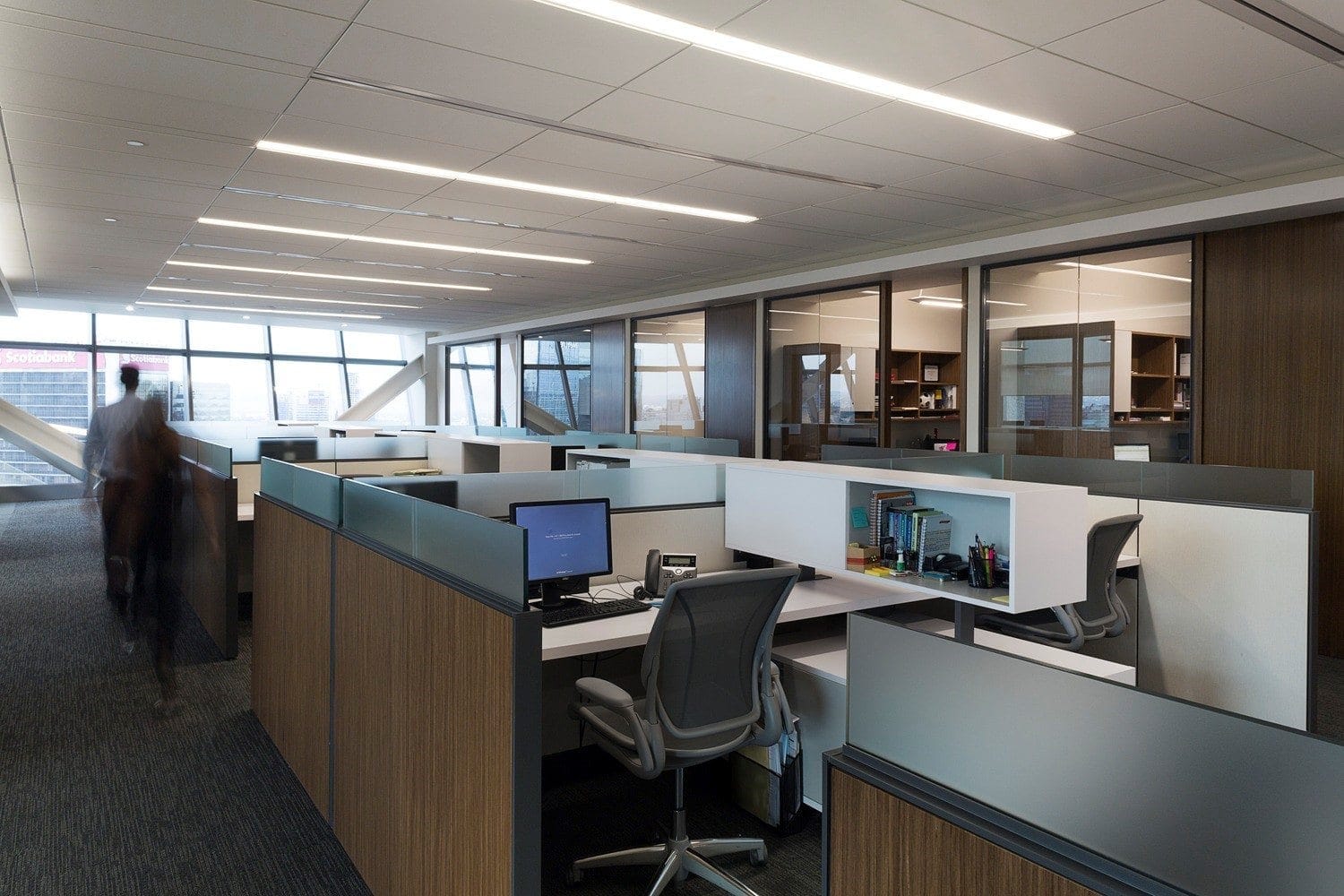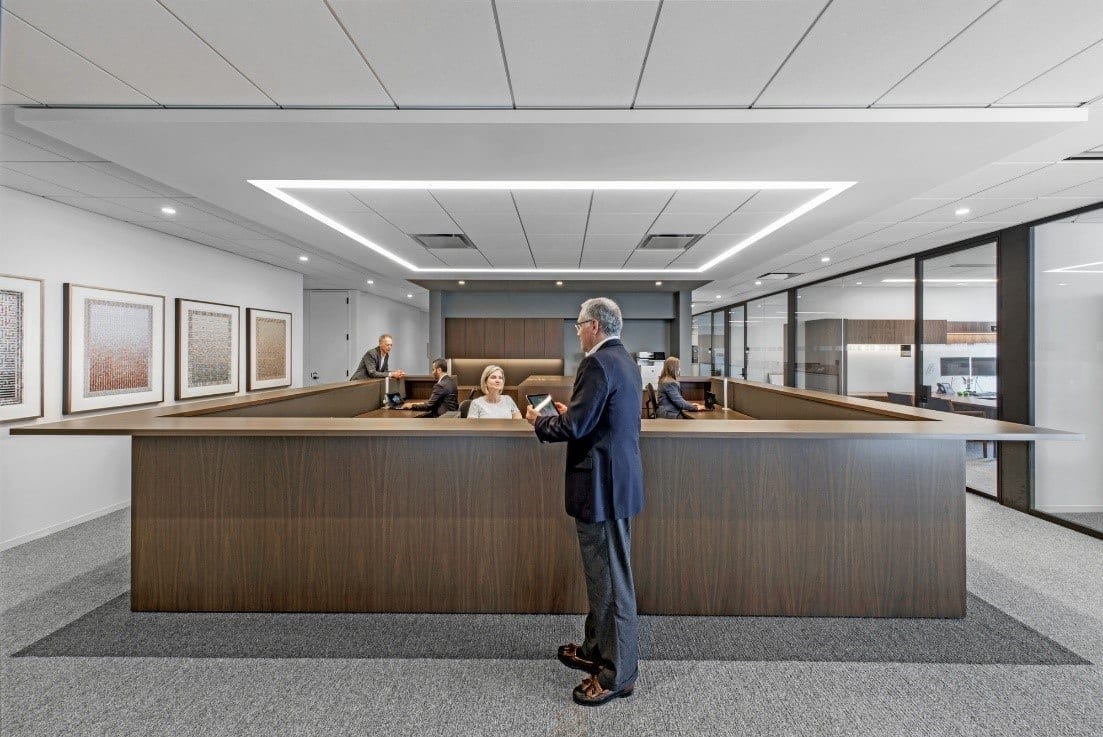
In Baker & McKenzie’s Mexico City location, traditional legal assistant stations have been done away with in favor of an open zone of standardized workstations that can be utilized interchangeably by a variety of support staff, giving great flexibility. Photo © Héctor Armando Herrera.
Recently a roundtable was held with members of the IA legal sector focus group and SB2 Consulting, a leading New York area law firm business consulting practice. Throughout the discussion, the group explored the business and space design drivers that have impacted law firms recently and touched upon a wide variety of topics. In this particular session, they discussed the evolving role of the legal professional assistant (LPA) and how changing administrative support ratios and tasks are affecting the physical design and business practices of law firms. This is part one of a four part series.
Change is in the Air
If you’re noticing changes in how law firms are treating legal professional assistant support functions, you are not alone. Younger, more tech-savvy lawyers are causing the needs of the practice to evolve, and as a result, the traditional legal assistant role is transforming radically—and in some cases even disappearing.

Mark Santiago is a partner at SB2 Consulting and has spent the past 30+ years helping law firms to find efficiencies in accounting, operations, M&A, and more. A frequent public speaker, Mark can often be found at legal industry events, giving presentations on law firm strategy, performance improvement, and partner compensation.
SB2 Consulting has been working with law firms for over 35 years and has witnessed this trend impacting how partners organize their practice. “When you look at information such as the Peer Monitor surveys published by Thompson Reuters, you see about one assistant for every three attorneys,” says Mark Santiago, a partner at the consulting firm. “That’s a significant improvement, but in a lot of our work, we’re pushing that number to five or six to one.” The roadmap for obtaining this ratio isn’t a simple one, and the key lies in identifying the different work that the LPAs are doing and identifying opportunities to enable specialization. “Much of the work that secretaries do does not actually require highly-technical skills—our surveys show that 35-40% of the work they’re doing is clerical in nature.” By supporting a trained legal assistant with two to three entry-level “practice assistants,” clerical work can be done at a much lower cost, and this blended group can assist many more attorneys.
Legal Assistant Ratios
The ratios are not steady across firms or practices, however. SB2’s research finds that Trust & Estates practices generally require more document-oriented tasks, and thus a significantly higher number of support staff. Litigation, on the other hand, requires more clerical activities such as assembling and duplicating documents and making copies. Other firms may elect to extend admin support to their paralegals, which would also skew the ratio. Ultimately, there’s no hard and fast rule, and the make-up of the support staff “pod”—a term used to denote the space where a legal assistant might sit with dedicated practice assistants—can be adjusted as needed to address changing requirements.

A support “pod” at the Troutman Sanders offices in Atlanta is surrounded by a continuous ledge for easy interaction with attorneys on all sides. Photo © Eric Laignel.
Pushing the Envelope
Some firms are taking this model further and moving to eliminate the role of the LPA entirely. Bartlit Beck, LLP, a boutique litigation firm in Chicago, has no designated legal assistants in the firm. While they employ administrative staff, much of this newfound efficiency can be credited to a stable of lawyers who take on many administrative tasks themselves, and have found new ways to integrate technology into their process. The jury is still out as to whether such a model can support a large general practice firm, but this model does serve as a strong reminder of the importance of examining the roles of support staff in a firm and making informed adjustments to improve efficiency.
Of all of these influences, it may be the new generation of lawyers that are most significantly impacting the administrative support ratio. “A lot of firms have moved to numbers far greater than what we’ve talked about here,” continues Santiago. “A large firm in Texas we’ve worked with has a stated goal of 10 to 1. We’re aware of a firm in Los Angeles where the ratio is currently 8 to 1—what’s really happening is that as the workplace gets younger, the ratio gets higher. They’re quite accustomed to doing a lot of these administrative tasks themselves.”

Russell Manthy is a Principal at IA, and plays a pivotal role in developing the firm’s law firm design practice. While his experience spans multiple client types, Russell has lead project teams in the development of innovative legal spaces in multiple countries for nearly 30 years .
The trend towards a paperless workplace is further helping to improve space efficiency. As servers and cloud storage are replacing filing cabinets and bankers boxes, the need to have designated filing areas is decreasing proportionally. IA’s Russell Manthy attested to the direct impact this trend has had on law firm design over the past three decades. “We’ve seen the number of linear feet of files per attorney driving down,” he reflects. “Right now, we’re seeing that number at about 15 linear feet on average, but some progressive firms are nearly paperless.” Easy and quick access to records stored offsite in remote locations – often managed by a separate company – are also taking a bite out of space needs for legal offices. Such trends, along with the diminishing size or disappearance of the law firm library and the reduced secretarial count have contributed to significant decreases in the amount of real estate needed to support law firms on a per-lawyer basis—for those who’s culture and practice support these changes.

Legal assistants are housed in groups of four in combined open areas just off the attorney corridor in this firm’s New York City offices. These spaces feature collaborative work counters and ample storage for project resources. Photo © Eric Laignel.
LPA Spaces
As the roles of assistants and administrative staff continue to evolve, the layout and planning of law firms must also change to accommodate them. “Once upon a time, the high quantity of secretarial stations that a law firm required provided a chance for architects to design large open areas on the lawyer practice floors in order to accommodate them,” says Erik Hodgetts of IA’s New York office. “But as the need for secretarial services has decreased, so has that opportunity.” He added that some firms have managed to keep these areas more open by adding paralegals or other legal support staff into the mix. By creating a standardized workstation type that can be used to house a variety of different personnel, even more openness can be provided. Another benefit is that such stations remain useful even when the quantity of legal professional assistants changes, leading to continuing, efficient utilization of the entire area. And these more expansive open neighborhoods outside of attorney offices can be further enhanced by the addition of specialized settings for group collaborative work.

Erik Hodgetts is a Principal at IA and a licensed architect who has worked in corporate and commercial interior workplace design for a wide variety of companies and clients. One of his specialties is law firm offices, and he helps to lead IA’s in-house legal group to track metrics, benchmarking, and trends specific to law firms.
Other strategies have included putting the smaller groups of assistants into shared interior offices open to the corridor, or even moving them to a dedicated ‘pool’ area in a single location in the office, removing them from the practice floors entirely. “We’ve even seen some firms dedicate small interior offices – typically with glass fronts – to individual LPAs, although the practice is not common,” Hodgetts noted, adding “It’s important to clearly understand a firm’s target metrics and strategy so that the space can accommodate it appropriately.” In any event, as legal support staff ratios and strategies continue to evolve, flexibility in design of the space is key in order to avoid having the office quickly become out of date. It’s clear also from the variety of options already in place that each law firm must carefully consider what features are right for them in order to find the best solution.